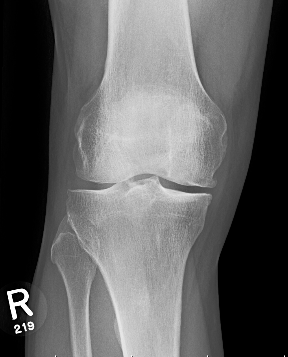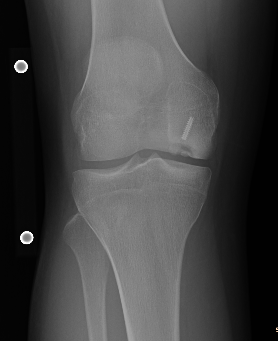

Young varus with OA Failed medial OCD with varus
Indications
Young active patient with
- medial compartment OA + varus malalignment
- medial cartilage restoration procedure with varus malalignment
- medial meniscus transplant procedure with varus malalignment
- posterolateral instability with varus knee
Rationale
Provides realignment of limb
- reduces abnormal loading stresses on damaged cartilage and bone
- redistributes forces to unaffected lateral compartment
Contra-Indications
Lateral or PJF compartment OA
Inflammatory arthritis
Smoker
Obesity
Lateral subluxation of tibia >1cm
Fixed flexion deformity
Flexion < 120o
Varus > 15°
Instability
Options
Lateral Closing Wedge HTO
Medial Opening Wedge HTO
Lateral Closing Wedge Osteotomy
| Advantages | Disadvantages |
|---|---|
| Inherently stable | Technically more difficulty as two osteotomies |
| Higher union rates |
Decrease proximal tibial bone stock Shortens leg |
| Better for larger corrections | Patella baja |
| Disrupt proximal tib-fib joint and risk injury CPN |
Medial Opening Wedge
| Advantages | Disadvantages |
|---|---|
| Technically easier / single osteotomy | Relatively unstable |
| Maintains bone stock especially with larger corrections | Risk delayed / nonunion |
| Able to correct coronal and sagittal planes | Lengthens leg |
| Can adjust correction more easily | Risk lateral hinge fracture |
| No fibular osteotomy | May increase PFJ pressure with large corrections |
Results
Outcomes with medial OA
Dal Fabbro et al Arch Orthop Trauma Surg 2024
- systematic review of HTO for medial OA
- 18 studies and 1300 knees
- 75% 10 year survival
- 87 knees with varus OA, minimum 10 year
- valgus > 8o: 87% 5 years and 66% 10 years survival
- valgus angle < 8o: 38% 5 year and 18% 10 year survival
- minimum 10 year follow up 106 HTO
- patients < 50 years with flexion > 120o: 95% 5 year, 80% 10 year, 60% 15 survival
Opening v Closing wedge HTO
- meta-analysis of OW v CW with minimum 5 years
- no difference in 5 year survival
- OW: 92% 10 year survival
- CW: 85% 10 year survival
Duivenvoorden et al JBJS Am 2014
- RCT of OW v CW in 92 patients with 6 year follow up
- increased complications in OW
- increased conversion to TKA with CW (22%) compared to OW (8%)
- 183 patients with minimum 10 years follow up
- conversion to TKA lower for opening wedge versus closing wedge
Computer navigation
- meta-analysis of computer navigated versus conventional HTO
- reduced outliers with computer navigation
HTO versus Unicompartment Knee Arthroplasty
Outcome
- meta-analysis of 38 studies and 9000 patients
- UKA less pain, fewer complications, better outcome scores
- HTO better ROM and lower revision
Revision to TKA
- Korean database
- 10 year revision rate TKA: 2%
- 10 year revision rate TKA after HTO: 2%
- 10 year revision rate TKA after UKA: 4%
